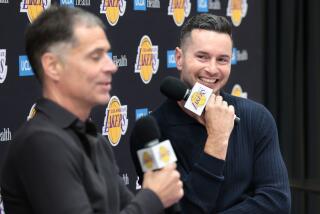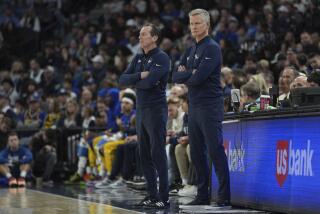Pete Newell dies at 93; Hall of Fame basketball coach guided Cal to 1959 NCAA title
Pete Newell, who coached UC Berkeley to the 1959 National Collegiate Athletic Assn. basketball title and was one of only three men to guide teams to National Invitation Tournament, NCAA and Olympic championships, died Monday. He was 93.
Newell, a resident of Rancho Santa Fe, died at the nearby home of Dr. Earl Shultz, one of his former Cal players who had been caring for him. Newell had been in poor health since lung surgery in 2005, his son Roger said.
By winning the then-prestigious NIT with the University of San Francisco in 1949, guiding Cal to the NCAA title and winning the 1960 Olympic gold medal with a roster that included Oscar Robertson, Jerry Lucas and Jerry West, Newell became the first coach to claim all three titles.
The only others are Dean Smith and Bob Knight.
West and a writer had planned to meet with Newell on Monday to do an interview for an upcoming book, Roger Newell said.
“He was my Olympic coach,” West said later Monday. “He was my mentor. When you are around a guy like him, you realize how beloved he really is. He was a great teacher. He loved basketball. He loved to teach young kids how to play basketball.”
“In his time, I think he was one of the better coaches the game has ever seen,” former UCLA coach John Wooden, a close rival of Newell early in his career, said in 2005.
“When I think of the outstanding teachers of the game, he ranked up there with the very best,” Wooden said.
Knight, a generation younger than Newell, considered him a mentor.
“From a personal standpoint, no one had a greater influence on what I do or try to teach than Pete Newell has had,” Knight said.
“The influence he had in basketball has been something that carried on for over 60 years, beginning when he was coaching at the University of San Francisco.”
Hall of Fame
Inducted into the Naismith Memorial Basketball Hall of Fame in 1979, Newell was elected not as a coach but as a “contributor,” because his brief but stellar career was a year short of the 15-year requirement for coaches.
He retired from coaching in 1960 at only 44 -- in part because of the self-induced stress that contributed to his chain-smoking, chugging coffee and going without food before games, and in part, he later suggested, because of his discomfort with the adulation surrounding him.
Though he left the bench early, by the end of his life, Newell’s effect on the game had extended almost five decades after his retirement as a coach.
As general manager of the Los Angeles Lakers from 1972 to ‘76, Newell made the trade that brought Kareem Abdul-Jabbar to the Lakers in 1975 -- a watershed in the history of L.A. sports -- after Abdul-Jabbar let it be known he wanted to leave the smaller-market Milwaukee Bucks for either New York, where he grew up, or L.A., where he played college ball for UCLA.
Newell sent Elmore Smith, Brian Winters, Dave Meyers and Junior Bridgeman to Milwaukee to acquire Abdul-Jabbar along with Walt Wesley.
In the late 1970s, Newell began an annual clinic that came to be known as the Pete Newell Big Man Camp, a summer training ground for more than 250 NBA players over the years -- with a list of alumni that included Shaquille O’Neal, Hakeem Olajuwon, James Worthy, Scottie Pippen, Sam Perkins, Jermaine O’Neal and the Lakers’ Andrew Bynum, who was 17 when the 89-year-old Newell first tutored him.
Guards not invited
Though there was never an official height requirement for the camp, guards were not invited.
“I just don’t feel I could do what I want to do, which is keep the American center in business,” Newell said at the 2005 camp in Las Vegas, where he counseled players even though he was less than five months removed from lung cancer surgery.
Newell considered today’s players “over-coached but under-taught,” meaning coaches focus too much on strategy without teaching players fundamental skills. In his camp, Newell emphasized footwork, spacing and a versatile array of individual offensive moves for post players in his camp.
“To me, the center position is the most demanding and important in basketball,” he said. “I think Bill Russell proved that with the amount of championships he won in the NCAA and NBA. Today, Shaq [Phoenix Suns center Shaquille O’Neal] is an example of how important the center can be.”
Though his legacy in the NBA is tied to the big men whose skills he honed as a college coach, Newell made the most out of the undersized and the less-talented, and he did it with defense, discipline and conditioning.
‘Hands up’ drill
At a 2005 reunion of players from his teams at Cal and Michigan State, where Newell coached from 1950 to 1954, men nearly 50 years removed from their college days let out a collective groan at the mention of the “hands up” drill -- an exhausting knees-bent, hands-up defensive shuffle that Newell required his players keep up for as much as 20 minutes at a time.
“Apart from intelligence, he looked for toughness,” said Stan Morrison, a member of the 1959 Cal team who went on to coach at Pacific, USC and San Jose State and is now athletic director at UC Riverside.
One of the players most emblematic of the rugged work ethic Newell prized was the star of Cal’s championship team, Darrall Imhoff, a onetime walk-on who went on to become a 12-year NBA center despite a single-digit career scoring average.
Making it hard for the other team to score was the cornerstone of Newell’s coaching philosophy.
Cal won the 1959 NCAA title by defeating two of the great offensive stars in basketball history in consecutive games: future Hall of Fame players Robertson of Cincinnati and West of West Virginia.
“Defense was his game,” Morrison said. “Of all the innovations, the one that stands out was what was called ‘sloughing defense.’ It was a helping defense, and back then everybody used to guard their man like they owed him money.”
Robertson led the nation in scoring in 1959, averaging almost 33 points, but against Cal in the NCAA semifinals, he made only five of 16 shots and was held to 19 points. The next year, the teams met in the semifinals again, and Robertson -- a three-time college player of the year -- made only four of 16 shots and finished with 18 points.
The Cal defense in ’59 so impressed Fred Taylor, the Ohio State coach, that he sought out Newell at a coaching clinic and spent hours with him, learning the nuances of the system.
The next season, Cal met Ohio State in the title game and lost by 20 points, though it might not have been only the defense: Ohio State had future Hall of Fame players Jerry Lucas and John Havlicek and a bench player named Bobby Knight, a future Hall of Fame coach.
Later, beginning when Knight was a young coach at Army, he and Newell became close friends -- perhaps not kindred in personal style, but in their love of the intricacies of the game.
“I think Pete probably understands the game better than anybody, ever,” Knight told author Bruce Jenkins in the 1999 biography, “A Good Man: The Pete Newell Story.”
“In all of sport, I think Pete is the least-known outstanding figure there is,” Knight said. “He was at his best at a time when media coverage was nothing like it is now. Just imagine if he won the NCAA title today, went back to the title game the following year, then coached the Olympic team. He’d be at the forefront of everything. And he’s so unusual, he has no animosities, no regrets whatsoever about leaving coaching when he did. You never hear, ‘Boy, I wish I could have. . . . ‘ He is more at peace with himself and what he’s done than any person I’ve known in my life.”
Born Aug. 31, 1915, in Vancouver, Canada, Newell grew up in Los Angeles.
His mother, Alice, made her son into a reluctant child actor for a time, and he appeared in several of the “Our Gang” movies.
But sports soon consumed Newell’s interests.
After graduating from St. Agnes High School at West Adams Boulevard and Vermont Avenue, Newell played basketball at Loyola University, now known as Loyola Marymount, and began moonlighting before he graduated, coaching football, basketball, track and softball at a local prep school.
Career ends
It was a coaching career that began early, and in the eyes of some, ended far too soon.
Morrison, his former player, believes Newell was “embarrassed out of coaching” by the adulation that came with Cal’s success.
“People attribute it to coffee and cigarettes, but I attribute it to that,” Morrison said. “He was such a humble guy and it was just too much. Everyone would be on their feet when he came out, and we’d put the ball down and applaud. Even the visiting team would do it sometimes.”
Newell acknowledged his discomfort in Jenkins’ 1999 biography. “It goes way back to my early days as a kid, when I hated everything that came with being an actor,” he said. “Obviously, my health was the major thing. But toward the end there, the whole experience was kind of chokin’ me.”
Some people find it hard to resist what Morrison called the “woulda-shoulda-couldas” about what Newell might have accomplished if he had coached more than 14 years. A few of Newell’s ex-players and colleagues still bristle over perceived slights in the rivalry with Wooden, who had not yet won an NCAA title when Newell won his first but finished with a record 10.
“Each of us had a pretty good streak against each other as far as victories,” said Wooden, who won the first seven games his teams played against Newell’s. Newell won the last eight.
“We were competitors, but we were always friends,” Wooden said, adding that he admired the discipline and fundamentals of Newell’s teams, particularly their defense. “I learned from him,” Wooden said.
Newell, whose wife, Florence, died in 1984, is survived by their sons, Pete Jr., a former high school basketball coach who guided Santa Cruz High to the 2005 California Division III state championship; Tom, a former assistant coach and scout in the NBA and WNBA; Roger and Greg, as well as five grandchildren and one great-grandchild.
A public memorial service at Loyola Marymount is planned for sometime after Thanksgiving.
Norwood is a former Times staff writer.
Times staff writer Broderick Turner contributed to this report.
More to Read
Start your day right
Sign up for Essential California for the L.A. Times biggest news, features and recommendations in your inbox six days a week.
You may occasionally receive promotional content from the Los Angeles Times.






